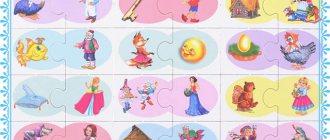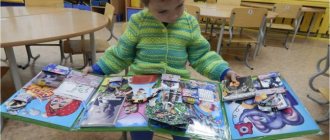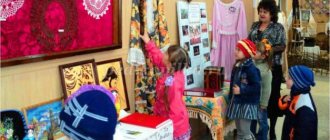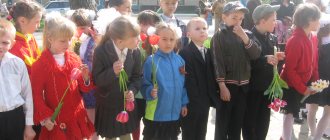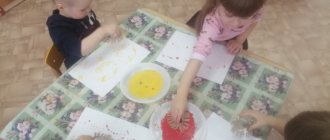Strengthening and protecting health from the first days of a child’s life is the task of every parent. And, as soon as the baby grows up and begins to attend kindergarten, teachers partially take on this task. The duty of any preschool institution is to take care of the physical and psychological well-being of pupils. Protecting children's health in preschool educational institutions
involves regular implementation of hardening, developmental and preventive measures. In addition, special attention is paid to building and maintaining a rational daily routine, quality nutrition and physical activity for each child.
Strengthening the health of children in preschool educational institutions
impossible without a range of physical exercises. Morning exercises, developmental activities, games and competitions, exercises for the prevention and correction of poor posture and flat feet, walks, exercises using sports equipment in the fresh air, etc. These activities strengthen the musculoskeletal system, improve blood circulation and breathing, help normalize digestion and metabolism, and strengthen the immune system, especially during periods of high risk of illness.
Methods for improving the health of children in preschool educational institutions also focus on the development of positive emotions in pupils. Physical education and sports activities do not aim to hone the technique of performing exercises. They are aimed at developing interest in sports and physical activity, promoting the emergence of positive emotions and strengthening children’s contact with teachers, teaching children to feel their body and move freely.
Finally, maintaining health in a preschool educational institution is impossible without hardening procedures. Hardening techniques change throughout the year, depending on weather conditions and the situation with the spread of seasonal diseases (flu, ARVI, etc.). Also, the type of hardening procedure and its intensity may vary from student to student. An individual approach is important here, taking into account the health status of each child, the characteristics of his character, physique and immunity. In order for hardening not to harm, but to bring benefit, all these parameters must be taken into account.
Next, we will consider the different types of health activities and their features.
Physical education classes
Health improvement of a child in a preschool educational institution
necessarily includes physical exercise. These or other types of exercises are selected by the physical work teacher, taking into account the age of the children.
Thus, in younger groups, the main goal of classes is to teach children to navigate in space and work with simple sports equipment and equipment. In middle groups, classes are more focused on the development of physical qualities - strength, endurance, agility. In older children, they instill the need for active movement, teach independence, organization and group work.
Any physical activity should, first of all, bring joy to the child. Therefore, the correct methods for improving the health of children in kindergarten are always varied. These are not only traditional gymnastic and sports exercises, but also outdoor games of varying intensity, rhythmic exercises, competitions and relay races, story-based exercises and much more.
Health improvement for children in winter in preschool settings
Sheina Tamara Yuryevna Skrynnik Yulia Igorevna teachers MBDOU Kindergarten No. 3 village. Bekhteevka, Korochansky district, Belgorod region.
The material was sent for publication in the All-Russian printed collection of practice-oriented materials “Preschool and primary education - modern methods and technologies of teaching and upbringing” - OCTOBER 2022.
HEALTH HEALTH OF CHILDREN IN THE WINTER PERIOD IN PRESENTER CONDITIONS
Currently, one of the most important and global problems is the health of children. Raising a healthy child is the most important thing that needs to be done not only by parents, but also by kindergarten employees. Full physical development and health of a child is the basis for personality formation.
Advertising message
Protecting and strengthening the health of children, comprehensive physical development, hardening the body - this is the main goal of the staff of our kindergarten. Prevention of colds - in our preschool institution in the winter and not only, largely depends on the interaction of us, the teachers, with the physical education instructor and with the nurse. It is known that absolutely any disease is much easier and better to prevent than to treat it later. The best protection against a cold is its comprehensive prevention.
The basic preventive principles are simple, which we use in our kindergarten and are well known to everyone:
- Hardening procedures;
- morning exercises;
- carry out physical education activities in the fresh air;
- walking along a ribbed path barefoot;
- wash your hands up to the elbows with slightly warm water;
- rinsing your mouth after eating; etc.
- implementation of sanitary and hygienic regime;
- Constantly monitoring the child’s posture during games and activities
The system for preventing colds and improving the health of children in our kindergarten includes breathing exercises, health-improving exercises after sleep with elements of self-massage, and oxygen cocktails.
- – optimal motor activity, physical education;
- – regular ventilation, quartz treatment and wet cleaning of premises;
- – sufficient lighting and properly selected furniture;
- - exclude the possibility of personnel, as well as children with signs of influenza or ARVI, going to work;
- – vaccination against FLU, which is given immediately before the winter respiratory viral season.
Only with regular and systematic use will this complex help overcome frequent illnesses in kindergarten.
During winter, air and water hardening should be widely used.
A necessary condition is sufficient ventilation of playrooms and bedrooms, sports and music rooms. Proper quartzization and ionization of premises prevent the impact of some unfavorable factors of the winter season on the child’s body.
I, a middle school teacher, together with a physical education instructor, select exercises and classes for various types of physical improvement for children. The main ones are:
- – organization of independent motor activity of children in a group and on a walk;
- – preparation of recommendations for parents on organizing physical activity in the family.
One of the important conditions for hardening is also the full use of walking time to stay in the fresh air while gradually accustoming children to low temperatures, subject to the recommendations of SanPiN of August 2013, paragraph 11.5.
Clean air is the key to health. One of the elements of hardening is a walk in the fresh air. A walk in winter brings joy to children no less than in summer. In winter, my children and I enjoy playing with the snow: we sculpt snow figures, ride on ice slides.
Maximum use of the winter season for the health of children, their physical development, hardening, and emotional charging contributes to the protection of the health of the younger generation in our kindergarten.
In winter, favorable conditions are created to enhance metabolic processes and adapt the body to low temperatures.
When organizing the daily routine in winter in our kindergarten and directly in my group, the features of this season and the recommendations of parents are taken into account. In winter, there is a great opportunity for further development of basic movements - walking, running, throwing, etc., which are carried out in changed, more difficult conditions (slippery surfaces, weighted clothing, etc.).
To improve the child’s physiological functions and develop a variety of motor skills, I use outdoor games, winter sports exercises and outdoor entertainment. They develop strength, endurance, agility in children, make them bolder, more decisive, and foster a sense of teamwork.
Skiing, ice skating, sledding - these types of physical activity are acceptable only in winter and are needed by a person in all periods of his life.
We must not forget that when selecting winter clothing, it is necessary to strive for optimal thermal comfort, remembering the dangers of overheating in children.
Protecting and strengthening the health of children, comprehensive physical development, hardening the body - this is my main goal and the goal of all employees of our preschool.
Bibliography:
- Dybina O.V. Classes on familiarization with the outside world in the middle group of kindergarten. M.: Mosaic-Sintez, 2007.
- Korotkova T.A. Cognitive and research activities of an older preschool child in kindergarten – Preschool education – 2003.
- Prokhorova L.N. Organization of experimental activities for preschool children. –M.: ARKTI, 2005.
- Savenkov A.I. Educational research in kindergarten - Preschool education - 2000.
You can see the table of authors and learn more about the collections HERE
Hardening
Health improvement for children in kindergarten
impossible without hardening procedures. When working with children, it is important to follow the key principles of hardening:
- carry out hardening procedures only with healthy children;
- refuse hardening if the child reacts negatively to it - cries, worries, is afraid;
- start with gentle procedures, gradually moving to more intense ones;
- carry out hardening regularly and systematically.
In a kindergarten, a medical worker must keep a hardening notebook, where the procedures performed, the children’s reaction, the results achieved and available medical outlets will be noted.
Basic hardening techniques, which include health improvement work in a preschool educational institution
:
- extensive washing with cool water. The child alternately runs wet palms over both arms from the hand to the elbow, then over the neck, upper chest and face, after which he wipes himself dry;
- daytime sleep without T-shirts - this procedure can be carried out in the warm season;
- rinsing the mouth with an iodine-salt solution (3-5 drops of iodine and a tablespoon of salt per 1 liter of water at room temperature), recommended after exercise or napping;
- walking barefoot;
- the so-called “Riga technique” - walking on a mat with rubber spikes soaked in saline solution.
The system of health work in kindergarten; educational and methodological material on the topic
System of physical education and health work
Full physical development and health of a child is the basis for personality formation. Children's physical health is inextricably linked with mental health and emotional well-being. The system of physical education and health work includes therapeutic and preventive and physical education and health activities. Every year at the beginning of the school year, a plan of health activities for the year is drawn up:
- Morning exercises /daily throughout the year/
- Gymnastics after sleep /daily for a year/
- Physical education classes /3 times a week/
- Airing the bath /before, after sleep/
- Finger gymnastics /3 times a week/
- Preventive vaccinations
- Fortification: juices, drinks, syrups, vitamins /daily
- Hardening by sun, water /in summer/
- Prevention of flat feet /daily/
- Prevention of children’s posture /daily/
- Physical education minutes /daily/
- Outdoor games /daily/
- Walks /in the warm season/
- Gargling /daily/. With herbs /1 time per quarter for 10 days/
- Work with parents on preventative health activities throughout the year. For the full physical development of children and to meet their needs for movement, the following conditions have been created in the preschool educational institution:
- sports/music hall equipped with sports complexes and sports equipment;
- there is a sports ground for outdoor and sports games
- There is a medical block.
The effectiveness of physical education and health work in a preschool institution largely depends on the interaction of teachers with a nurse, music director, and psychologist. A work plan for joint activities for the year is drawn up in advance, including consultations for educators and presentations at pedagogical councils. Medical and pedagogical meetings are planned.
Consultations for educators: “Features of doing gymnastics after naps,” “Children’s physical readiness for school.”
Planning speeches at teacher councils: “Protecting the life and health of children”, “Results of health improvement work”.
Planning of medical and pedagogical meetings “Effectiveness of physical education and health work”, “Results of health work”. In their work, kindergarten teachers use various types of activities, among which the predominant ones are:
- plot-game activities, consisting of outdoor games of varying degrees of intensity;
- competition classes: children are divided into teams and winners are identified during various relay races;
- training sessions for basic types of movements;
- classes according to the traditional scheme: water-preparatory part, general developmental exercises, outdoor games;
- test classes in which children pass physical standards against time.
Most of the time in a preschool institution, a child is in a group, so the preservation and strengthening of their health depends on how competently the teacher’s activities in organizing the children’s routine are structured.
Of course, it would be nice if the kindergarten had a physical education instructor who would help the teachers, but in our preschool educational institution there is no such thing, so the teachers themselves select exercises and activities for various types of physical development of children. The main ones are:
- selection of exercises for physical education classes, for gymnastics, for organizing games between classes;
- equipment for a physical education corner;
- organization of independent motor activity of children in a group and on a walk;
- drawing up recommendations for parents on organizing physical activity in the family.
The main problems requiring joint activities of teachers and nurses are:
- The physical condition of children attending preschool institutions.
- Optimization of the motor mode of children in preschool educational institutions.
- Prevention of diseases.
- Formation of ideas about a healthy lifestyle in children.
The system of health-improving work carried out in our kindergarten includes the following activities: breathing exercises, preventive foot massage, prevention of posture disorders and flat feet, herbal bar. Every day, in all age groups, several forms of physical education and health activities are implemented: morning exercises in the hall and in the open air in the summer, a variety of outdoor games throughout the day, physical education classes in the hall and in the air. Together, these forms of activity make it possible to ensure children’s physical activity throughout the day and rationally distribute children’s intellectual and physical load. The kindergarten nurse also carries out many preventive measures to prevent diseases in the autumn-winter period. This includes maintaining cleanliness, quartzing groups, disinfecting during an ARVI outbreak, and ventilating groups before going to bed. The content of health-improving physical education classes includes special exercises that teach children to breathe correctly or sets of breathing exercises.
Preventive exercises for the upper respiratory tract.
Goal: To teach children to breathe through their nose and prepare them to perform more complex breathing exercises.
Tasks:
- Increase vitality and resistance, hardening, resistance of the body to diseases of the respiratory system.
- Develop respiratory muscles, increase chest mobility, improve lymph and blood circulation in the lungs.
Basic Rules.
- Breathe with pleasure: positive emotions in themselves have a significant healing effect.
- Concentrating on the breathing exercise increases its positive effect.
- Breathe slowly to saturate the body with oxygen.
- Breathe through your nose.
One of the common ways to increase the body's resistance in kindergartens is the use of acupressure.
Hand massage
Purpose: to influence internal organs through bioactive points of the fingers, to evoke feelings of lightness and joy.
- “Wash” your hands, actively rub your palms until you feel intense warmth.
- Extend each finger and press on it.
Rub the phalanges of the fingers of one hand over the nails of the other, as if on a washboard. Rub the entire arm up to the shoulder with a “washcloth”, pressing forcefully on the muscles of the shoulder and forearm; “Wash off the soap with water”: move one hand up, then with your palm down and “shake off the water.”
Ear massage
Goal: to evoke the image of a favorite toy and, during the game, influence the hearing aid and active points of the intestines that are located on the ears. The child, sitting cross-legged, “sculpts” ears for Cheburashka or for a kind, sweet elephant:
- strokes the ears along the edges, then along the grooves inside, behind the ears;
- gently pulls the ears up, down, to the sides (5-6 times);
- presses on the earlobes (“hangs beautiful earrings on them”);
- sculpts the ears from the inside (with your fingers inside the shell, makes 7-8 rotational movements, first clockwise, then counterclockwise - the ears will be clean and all-hearing);
- with force “smears clay” around the ears - checks the strength, smoothes the surface around the ears at a distance of 1-1.5 cm.
Head massage
Purpose: To influence active points on the head that improve blood flow.
- Using strong finger pressure, the child imitates washing his hair.
- With his fingers, like a rake, he leads from the back of the head, temples, forehead to the middle of the head, as if raking hay into a haystack.
- Makes spiral movements with his fingers from the temples to the back of the head.
- “Catch-up.” Hitting hard with the pads of the fingers, as if on a keyboard, it “runs” across the surface of the head. The fingers of both hands either run together, then run away, then run away from each other, then catch up.
- With love and affection, he runs his fingers through his hair, like a comb, imagining that his “hairstyle is the most beautiful in the hairstyle competition.”
Face massage
Goal: prevent colds by influencing the active points of the face, develop the ability to control facial expressions, and “sculpt” a beautiful face.
- The child strokes the forehead, cheeks, wings of the nose from the center to the temples, gently taps the skin, as if compacting it so that it becomes elastic.
Presses his fingers on the bridge of the nose, on the middle of each eyebrow, making rotational movements, first clockwise, then counterclockwise (5-6 times).
- With force, pressing on the skin, he draws a beautiful curve of the eyebrows, then with plucks he sculpts thick eyebrows (from the bridge of the nose to the temples).
- Softly and gently sculpts the eyes, pressing on their corners and combing long fluffy eyelashes.
- Pressing on the wings of the nose, he moves his fingers from the bridge of the nose to the nasal sinuses, tugging at his nose: imagining what a beautiful Pinocchio nose he will get.
In kindergarten, health-improving activities are given one of the main places:
- nurturing a reasonable attitude towards health from childhood, a correct daily routine;
- rational, balanced nutrition;
- optimal physical activity, physical education;
- hardening – adaptation of the body to various environmental conditions;
- preventive work (rinsing the mouth with herbal decoctions, garlic-lemon infusion, etc.);
- health-saving technologies and general health activities.
One of the areas of our activity is the education and need of children for a healthy lifestyle. To instill in children the need for a healthy lifestyle, they must know:
- the importance of a healthy lifestyle;
- understand the peculiarities of the functioning of the body, the rules for protecting the senses;
- serve yourself, analyze your actions and the actions of other children;
- interact with the environment, understand under what conditions the habitat (home, street) is safe for life;
- learn self-massage techniques;
- learn and understand which habits and why are harmful to health. How to behave correctly in society.
Thematic lesson planning
| Month | Topic of classes |
| September | That's who I am |
| October | Be always healthy! |
| November | How we breathe |
| December | How do we hear |
| January | Sharp eyes |
| February | Tongue and healthy teeth |
| March | Hair, nails and skin - that's what protects me |
| April | What's inside me? |
| May | Rules for life |
At the Pedagogical Council, the team decided to hold a monthly health day.
It’s good to plan the following health-improving physical education activities in kindergarten on this day:
- Classes of the classical type, the so-called “classic version”.
- Game activities based on outdoor games (including folk games), recreational games, relay games, and amusement games.
- Walking – hiking. This is walking over certain distances.
- Story-based activities. They fit well on a walk.
- Classes at sports complexes and exercise machines (if any).
- Classes based on dance material. Their content includes musical and rhythmic warm-up, dancing according to the degree of increasing load, and round dances.
Independent physical education classes. The modifications of these activities can be very diverse; there is no limit to the creativity of educators.
- Classes - training. These are special classes aimed at developing cardiovascular endurance.
Planning “Health Days” in kindergarten will help raise children healthy, resilient, and physically prepared for the second stage in a child’s life, i.e. entering first grade.
HEALTH DAY AT MBDOU
Children are looking forward to the holiday, preparing chants, practicing, and training their will to win.
Preventive actions
Health of preschool children
is also supported by a set of preventive measures aimed at preventing colds and other diseases. Such measures include sets of visual exercises to prevent myopia, gymnastics with the simplest elements of yoga, breathing exercises, sleeping without pillows, self-massage of the earlobes and auricles.
During training sessions, pauses are required for relaxation, breathing and vision training. Particular attention is paid to the optimal motor mode, which is the best prevention of flat feet and postural disorders.
Finally, the preservation of the health of children in preschool educational institutions is ensured through the organization of a high-quality and safe environment. This, first of all, includes regular wet cleaning of kindergarten premises, ventilation, and maintaining optimal temperature conditions. Rooms where children play and sleep should receive sufficient natural light. In the autumn-winter period, as well as in the northern regions, the lack of natural light can be compensated by installing fluorescent lamps.
Physical education classes may be accompanied by music. A musical background promotes better coordination of movements, improves mood and stimulates children's activity.
How to monitor the health and morbidity of children?
It is convenient to use special software to analyze morbidity and maintain medical journals in kindergarten. For example, the “Medical Cabinet” software module of the System for Monitoring the Activities of an Educational Institution (SKDOU). It contains more than 30 medical journals that help monitor the health and morbidity of children, monitor dietary nutrition and the quality of food preparation, comply with food standards and the sanitary condition of premises, etc.
This is how, for example, the system looks like the formation of a vaccination plan and a schedule based on one of the morbidity reports:
You can download a free demo version of this program here.
Author of the article: Lidiya Sitnikova
